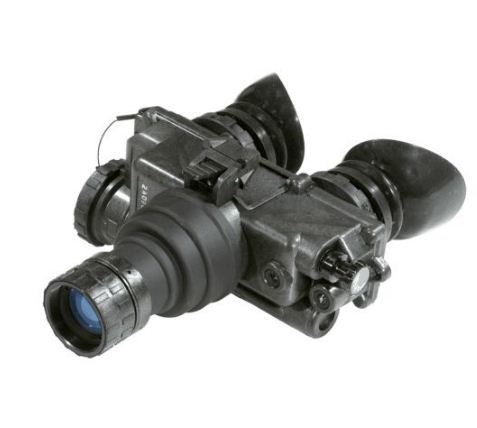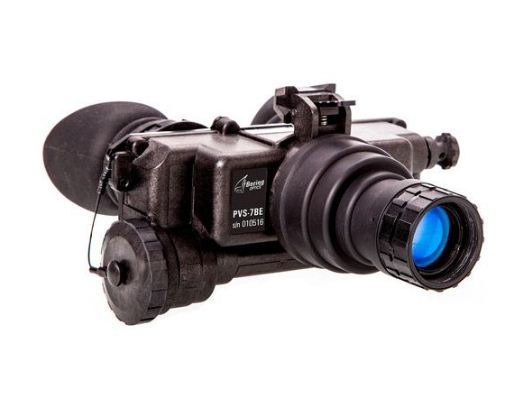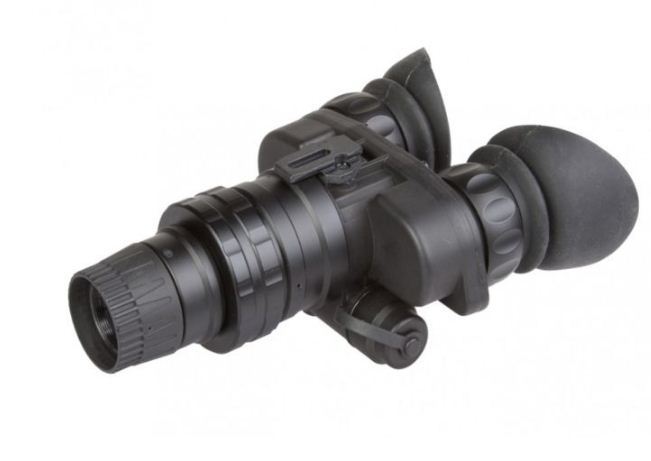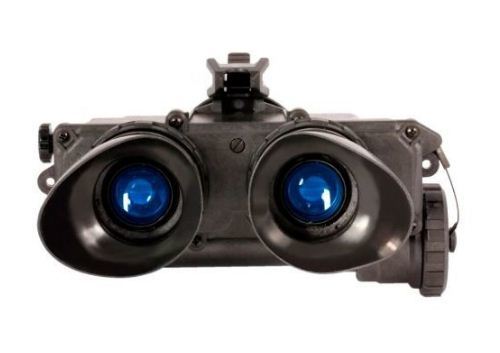Shopping for Gen 3 Night Vision Goggles?
Look no further!
While Gen 3 night vision goggles were initially designed for the military, the innovative optics are now used in a wide range of fields, including wildlife observation and hunting.
In this article, we've reviewed some of our favorite models to help you find a unit that best suits your needs.
Let’s dive right in!
Who Should Use Gen 3 Night Vision Goggles?
When it comes to civilian-grade night vision, there’s nothing better than Gen 3 night vision goggles. Because of their expensive nature, these models are usually reserved for law enforcement, the military, and those looking for the best devices on the market.
Gen 3 offers a tube life of around 7500 to 10,000 hours, trumping both Gen 1 and Gen 2 in life expectancy. However, the quality of each Gen 3 model varies greatly, depending on the features and specifications.
High-end units offer a remarkably clear, bright, and crisp image and perform exceptionally well in low-light conditions without the use of IR. They also let you choose between a manual and an auto-gated tube.
All Gen 3 night vision goggles boast state-of-the-art technology, but Gen 3 auto-gated models are designed with some of the most advanced night vision available today. The United States Military and Special Forces use these goggles, as they deliver excellent performance in all light conditions.
These units are also resistant to image distortion or “blooming” caused by bright lights, ensuring superior performance in all types of urban environments or anywhere that has artificial lights, such as flashlights or vehicle headlights.
What’s In This Buying Guide
A Gen 3 night vision goggle is a significant investment.
In this guide, we review some of the best models available today to ensure you don’t end up regretting your decision. We also include a comprehensive buying guide, explain how these optics work and answer a few frequently asked questions.
However, if you don’t like goggles and would like to opt for monoculars for night vision, then make sure to check out our reviews before you make a decision.
Best Gen 3 Night Vision Goggles
ATN PVS 7 Night Vision Goggles
Best Overall
Bering Optics PVS-7BE
Best for close-range shooting
AGM Global Vision Wolf-7
Best for civilians

The ATN PVS 7 has a lightweight design, excellent resolution, and incredible sensitivity in low-light conditions.
It is also easy to wear. Once you properly adjust the goggles, they’ll feel comfortable and you won’t experience eye fatigue.
The PVS 7 goggles produce a remarkably clear picture in almost all low-light conditions, even if you use the optics on an extremely cloudy night. All images appear crisp, sharp, and bright with very little noise.
This ATN model is dependable, high-performing, and robust. It’s identical to the device used as a standard issue by US Army ground troops and is specifically designed to provide reliable service and assist viewing in even the most disadvantageous conditions.
It further boasts an infrared illuminator and a continuous and momentary on-switching function. It also displays low battery and infrared operation indicators within its field of view, making it easier to use.
Moreover, it comes with a lightweight, completely adjustable military head strap, allowing for comfortable extended use. Lastly, it boasts a full US Mil-Spec body and includes a shoulder strap, soft carrying case, sacrificial filter for the lenses, demist shield, lens tissue, front lens cap, and neck cord.
Some of its other notable features include:
- High-resolution Gen 3 tube with a low-occurrence blemish rating.
- 57 lp/mm to 64 lp/mm resolution.
- 225m recognition range and 300m detection range.
- 3-element eyepiece and 6-element lens system offer a wide field of view and excellent clarity.
- Digital controls allow users to deactivate or activate all features with a single push of a button.
The military-grade ATN PVS 7 Night Vision Goggles are rugged, dependable, and water and fog-proof, making them suitable for use in different conditions.
If you want a pair of high-end night vision goggles for a wide range of nighttime applications, then this unit is the way to go!
Pros
- Hard plastic armoring prevents corrosion and rust.
- Lightweight and durable design.
- Includes a battery and IR indicator.
- Wide field of view.
- Completely weather-resistant for better durability.
- Compliant with military specifications.
Cons
- Battery life is a bit shortNot ideal for long-range shooters or budget hunters.

The PVS-7BE is the Bering Optics’ version of the standard military PVS-7. You can mount this compact, rugged, and versatile night vision device to a helmet, wear it with headgear, or hold it in your hand.
It boasts an autogated power supply and a Gen 3 thin-film image intensifier tube. The model offers several advantages over a second-generation tube in terms of higher gain and greater sensitivity.
Boasting manual gain control, the unit gives you full control over the trade-off between image brightness and the amount of detail visible.
The 7BE also comes with a built-in infrared illuminator that illuminates your targets with extra infrared light, maximizing image brightness in complete darkness. The optic further boasts an activation status indicator to add stealth and convenience for tactical applications.
Moreover, it offers an automatic off function that automatically switches off the optic when you move it in the ‘UP’ position or remove your headgear. You can upgrade the 1x lens system to higher magnifications using optional lenses as well.
With a wide 40-degree field of view and an extremely short focusing distance of 10”, the Bering Optics PVS-7BE is perfect for close-range hunting or shooting.
Additional features include automatic brightness control, low battery and IR operation indicators, and an auto-shutoff function that switches off the device when it’s exposed to sudden bright lights.
It also boasts a lightweight, impact-resistant polymer housing, offers protection from extreme conditions and adverse conditions, and delivers waterproof and fog-proof performance.
The eyepieces are further designed with wide-winged rubber eyecups to offer a comfortable pad between the eyepieces and your eyes and prevent light from spilling over from the image intensifier tube.
Lastly, it has knurled adjustment rings, an ergonomic body, and a ¼”-20 socket that allows for tripod mounting.
Here are a few notable features:
- 400 field of view.
- Interpupillary adjustment ranging from 55mm to 76mm.
- f/1.2 lens system with a 26mm objective lens.
- Works with 3x-10x zoom objectives.
All in all, the Bering Optics PVS-7BE is a complete package, so you won’t have to worry about purchasing any additional accessories.
The optic’s wide field of view and comfortable and lightweight design make it ideal for extended use, while its user-friendly controls make it extremely easy to operate.
Pros
- Lightweight and ergonomic body.
- Good battery life.
- Excellent performance in low-light conditions.
- Compatible with a wide range of lenses.
- Ultra-short focus range.
- Includes several different accessories.
- Automatic brightness control increases battery life.
Cons
- Not suitable for pitch-black conditions.

The Wolf-7 is designed with an autogated Gen 3 image intensifier tube. An autogated IIT constantly works to enhance image contrast and clarity in varying lighting conditions.
An ion barrier and automatic voltage regulation further reduce blooming or spots caused by bursts of bright light, protecting both the intensifier tube and your eyes from damage. Although there are a few visible spots around the edges, the center is remarkably clear.
The model’s bi-ocular design further keeps the weight low and the size compact, making it more comfortable to wear the optic on your head or helmet.
Moreover, it boasts automatic brightness control that automatically adjusts the image intensifier tube's brightness in different light conditions.
The device’s rugged housing ensures that it withstands the rigors of use in disadvantageous conditions, while its waterproof design offers protection against driving snow and cold. It also features a wide operating temperature that allows you to use it in weather as hot as 158oF and as cold as -58oF.
The Wolf-7 night vision goggles need a bit of ambient light for a clearer view. They deliver exceptional resolution and gain in normal conditions, but they need the integrated wide-range IR illuminator to work in areas with absolutely no light.
This additional light also allows you to do gear and weapon checks and set up your landing zone without giving away your position.
A few of its notable features and specs include:
- Bi-ocular design for both-eyes-open use.
- 24mm, f/1.2 multi-coated lens system helps maintain a lightweight and compact form factor.
- Autogated tube controls the amount of light entering the intensifier and reduces blooms.
- Minimum 10” focus distance enables you to perform tasks like gear checks more efficiently.
Built with simple, reliable electronics and high-grade optics, the Wolf-7 offers clear and bright images at night, even in the most unfavorable conditions.
Rugged, compact, water-resistant, and lightweight, this unit is the ideal hands-free optic for a wide range of tough operations.
Pros
- Rugged and compact design.
- Extremely easy to flip up and down for quicker use.
- Automatic brightness control.
- Excellent battery life.
- Perfect for multi-purpose use.
- Multi-coated lens system.
- Automatic bright light cut-off saves battery.
Cons
- Limited waterproof capabilities.
Gen 3 Night Vision Goggles Buying Guide
Gen 3 Night Vision Goggles Explained
When you hear the words ‘night vision,’ the first thing that pops into your mind is an action or spy movie in which someone dons a pair of night vision goggles just before an important search and rescue mission.
But do these devices really allow you to see in the dark?
Well, yes, but there is a difference between the actual scene and what you see.
With the right NV device, you can clearly spot a person standing more than 200 yards away on a cloudy, moonless night.
Gen 3 night vision goggles are designed with image-enhancement technology and an image intensifier tube that collects and amplifies visible and infrared light.
A unit with the traditional green view works by collecting the available ambient light (infrared light, moonlight, or starlight) through its objective lens.
The light then reaches a gallium arsenide photocathode image intensifier tube, where the photons are converted into electrical energy or electrons.
Once these electrons pass through a microchannel plate (a unique, quarter-sized device), they are amplified.
The microchannel plate (MCP) has thousands of tiny channels that use a chemical and electrical process to strike the electrons that reach it against the channel walls, resulting in thousands of more electrons.
These numerous new electrons leave the MCP and hit a phosphor screen that converts the electrons into visible light or photons.
Lastly, this visible light travels through the optic’s eyepiece, allowing you to look at a bright greenish-hued version of the original display you were viewing.
How is Gen 3 Night Vision Different from Gen 2 and Gen 1?
When we talk about the generations of night vision technology, we’re not referring to the optic itself. Instead, we’re referring to the IIT or image intensifier tube inside the device.
To better understand the difference between the generations, we’ve explained the three of them separately:
Generation 1
Gen 1 night vision devices were developed in the early 1950s, making them the oldest of the three. Unlike Gen 2 and Gen 3, Gen 1 tubes don’t have a global standard, which means the quality of the tube can differ from optic to optic.
They’re ideal for short-range observation and hunting in low-light conditions and perfect for people who just want to experience night vision.
Gen 1 tubes often offer an imperfect and blemished view. These blemishes usually appear as black spots when you look at your surroundings through the lens.
Generation 1 night vision goggles are usually built with an infrared illuminator for clearer pictures in low light conditions, but you can also attach a standalone torch for a brighter and crisper image. Their price can range anywhere from $500 to $1000.
Generation 2
Generation 2 night vision was a big step ahead of generation 1 in terms of life expectancy and quality. Gen 1 tubes have a service life of around 1,000 hours, while Gen 2 image intensifier tubes can offer approximately 2,500 to 5,000 hours of use.
Gen 2 units are designed with a micro-channel plate, enabling them to produce a much brighter and clearer image than their Gen 1 counterparts.
The addition of the MCP in Gen2 night vision goggles also allows manufacturers to offer a wider range of detection, the ability to display a higher-quality view in low light conditions without using an IR, and image quality that’s closer to Gen 3 than it is to Gen 1.
Generation 3
The US Military currently uses Gen 3 optics. Although there are no significant changes in the basic technology from Gen 2, Gen 3 NVGs have even better sensitivity and resolution.
This is because they feature a gallium arsenide photocathode that is highly efficient at converting photons into electrons. The MCP is covered with an ion barrier, which substantially increases the tube's service life.
Gen 3 night vision goggles are the costliest but have a 300-yard long-range view and the longest battery life, making them suitable for tactical applications. Their average service life trumps both Gen 1 and Gen 2 by offering 7,500 to 10,000 hours of use.
It’s essential to understand the main difference between the three generations.
Gen 1 NVGs don’t have a microchannel plate, a feature that plays a great part in light amplification.
While Gen 2 units are designed with microchannel plates for greater light amplification, they don’t have the same ion barrier or protective films that are standard on Gen 3 optics. This lack of an ion barrier shortens the service life of a Gen 2 image intensifier tube.
Furthermore, Gen 2 features a cheaper and older tri-alkali photocathode instead of a newer, more effective gallium arsenide one that offers increased detection ranges and improves low-light performance.
What to Look for in Gen 3 Night Vision Goggles

Although your decision ultimately comes down to your budget and personal preference, here are some things you should keep in mind before finalizing your purchase:
Weight
Most people use night vision goggles for an extended period of time, so it’s important to consider their weight. This is particularly true if you’re going to choose a unit with a helmet or head mount. A heavier pair of night vision goggles can result in neck strain.
It’s better to look for models that weigh less than 20 ounces. However, remember that more intensive, tactical units are designed with more lenses and have a higher weight by default.
Size
If you’re going to use your night vision goggles for hunting or just need a clear and unobstructed line of sight, you should consider the size. A unit that’s too large will make it difficult for you to use the optic with a rifle.
It’s better to opt for a model that you can easily retract and put away when you’re not using it, so you can safely use other devices with your rifle without any problems.
Gain
If you’re planning to use your Gen 3 night vision goggles in extremely dark areas, it’s essential to consider the gain. Gain refers to the ability of a night vision goggle to optically compensate for varying light levels.
A unit with a better gain offers a better viewing experience and clearer, crisper, and more detailed images in low-light conditions.
It’s advisable to look for a model that allows you to manually control the gain, especially if you’re going to use the optic in areas where the light levels fluctuate constantly.
Durability
Gen 3 night vision goggles are usually designed for active or outdoor use. Cheaper units typically offer poor performance, so it’s better to go for models with durable aluminum bodies instead of plastic ones if you want a pair of goggles that will last a long time.
Similarly, opt for glass lenses over other cheaper alternatives.
Autogaging
The auto gauging feature calculates the distance between you and your prey. As you move and scan across your screen, the optic changes the display accordingly.
Since this feature is similar to a rangefinder working in the dark, it’s important for long-range hunters and shooters.
Autogating
If you’re going to be working in variable light conditions or will be exposed to sudden flares of bright light, it’s better to get an autogated model.
Although this feature increases the price of the unit, it offers automatic brightness control that helps preserve your device when it’s exposed to bright light.
Integral Illuminator
If you’re worried about the weight of your optics, it’s better to choose a night vision goggle with an IR illuminator. This will allow you to read text in dark conditions even when you’re not using the goggles, as the illuminator is an independent light source.
Weather Resistance
If you’re planning on hunting in marshlands or camping in wet and damp areas, a waterproof or weatherproof rating is an important consideration.
If you’re going to work in areas with consistently bad weather, it’s a good idea to upgrade to a costlier weather-resistant device.
Avoid Magnification
While magnification sounds like a great feature, in theory, it can negatively affect your ability to walk or use other equipment safely. It’s better to skip magnification when you’re shopping for a night vision goggle.
Limitations of the Gen 3 Night Vision Goggles
While Gen 3 night vision goggles are designed with cutting-edge technology, they’re still not perfect and have a few drawbacks.
Looking through night-vision goggles is similar to looking down a tunnel. The human eye field of view is around 190-degrees, but with NVGs, it is cut down to only 40-degrees. This results in the elimination of your peripheral vision, preventing you from spotting dangers.
To adjust to this narrower field of view, you’ll have to constantly turn your head from side to side to scan your surroundings for any potential dangers.
Usually, you use both your eyes to pick up cues that help estimate the depth and distance of an object. However, with night-vision goggles, you’re only using one eye, which can cause significant problems.
For instance, when you look at two differently-sized objects placed side-by-side through a night vision goggle, the larger object seems to be nearer.
Similarly, when you look at overlapping objects through NVGs, the one placed in front appears nearer, probably much more so than it actually is.
Furthermore, some objects seem to be farther away than they really are when viewed through NVGs. This is because our brain tends to link the loss of detail with distance.
A light source that’s not part of the terrain might also appear closer than it really is. It’s crucial that you’re aware of all these limitations so you don’t underestimate depth or overestimate distance.
Along with a reduced field of view, other drawbacks of Gen 3 NVGs include the loss of color information, reduced depth perception, and image noise, all of which obscure the finer details.
Frequently Asked Questions
How are Gen 3 night vision goggles different from Gen 1 units?
Gen 1 night vision goggles are usually not designed with a microchannel plate and create images with lower resolution and more noise. They have a short service life of approximately 1500 hours and offer a maximum viewing range of around 75 yards.
On the other hand, Gen 3 is one of the most advanced night vision technologies available today.
Gen 3 goggles boast premium components, such as ion barrier films, to enhance tube durability. They deliver excellent performance in low-light conditions without using an IR illuminator and are suitable for both day and night use.
The optics have a lifespan of approximately 10,000 hours and offer a maximum viewing distance of around 300 yards.
Can civilians purchase Gen 3 night vision goggles?
Yes, United States citizens can buy and use Gen 3 night vision goggles. However, it is illegal to take these optics out of the country, no matter your purpose and intention.
Is thermal better than night vision?
Thermal is better than night vision for detection, but it is more expensive as well. This is because thermal imaging is a relatively new technology, making it costly to manufacture.
On the other hand, night vision gives you better identification than thermal vision. And since the military developed night vision around WWII, it is much more affordable as well.
Why are night-vision goggles so expensive?
Night vision goggles are not in high demand, so manufacturers are forced to hike their prices. Hunting is also banned in several different countries, further making night vision devices more expensive.
What is the average service life of a night vision scope?
The tubes of night vision scopes have a coating that makes their lifespan finite. A quality Gen 2+ scope has an average lifespan of around 5000 hours, while a Gen 3 optic can give you as much as 12000 hours of use.
What is the latest night vision generation?
Gen 3 is the latest and the best night vision technology in terms of civilian-grade night vision devices. However, due to the high price point, Gen 3 is usually reserved for law enforcement, the military, and those who use only the best optics on the market.
Although Gen 4 is available, it’s still classified as Gen 3 by the military. Gen 4 devices use film-less image tubes to enhance performance and clarity.
Can you use a scope with a night vision goggle?
Yes, you can use scopes with night vision goggles, but the positioning is a bit awkward, and you might damage your rifle, riflescope, or night vision goggles.
Can night vision devices offer clear images in smoke?
Night vision devices are negatively affected by weather-related obscurants, like rain, fog, snow, blowing sand, and smoke. They are unable to perform under these weather conditions.
Will my night vision goggles glow in the dark when I turn them on?
Yes, it will glow in the dark, but not from the front. The green or white light will be reflected onto your face around your eyes, making it easier for you to perform weapon checks in the dark.
Final Verdict: What are the best Gen 3 Night Vision Goggles?
Gen 3 night vision goggles are quite a costly investment, so it’s vital that you make the right and very informed decision.
We found the ATN PVS 7 Night Vision Goggles to be the best ones available today.
However, if you’re a civilian and just want to up your night vision game, the AGM Global Vision Wolf-7 NV Goggles might be more suitable for you.
Similarly, if you just want something for close-range shooting, it’s better to go with the Bering Optics PVS-7BE Night Vision Goggles.